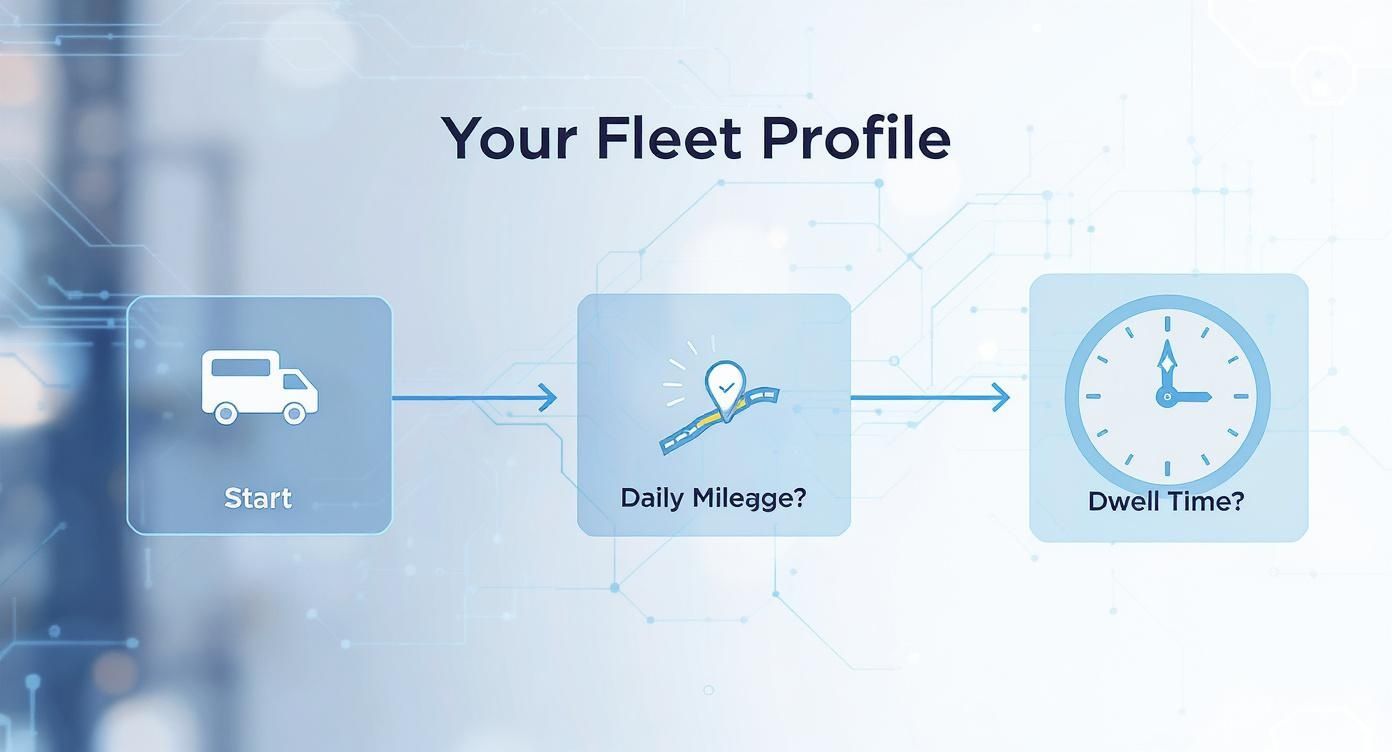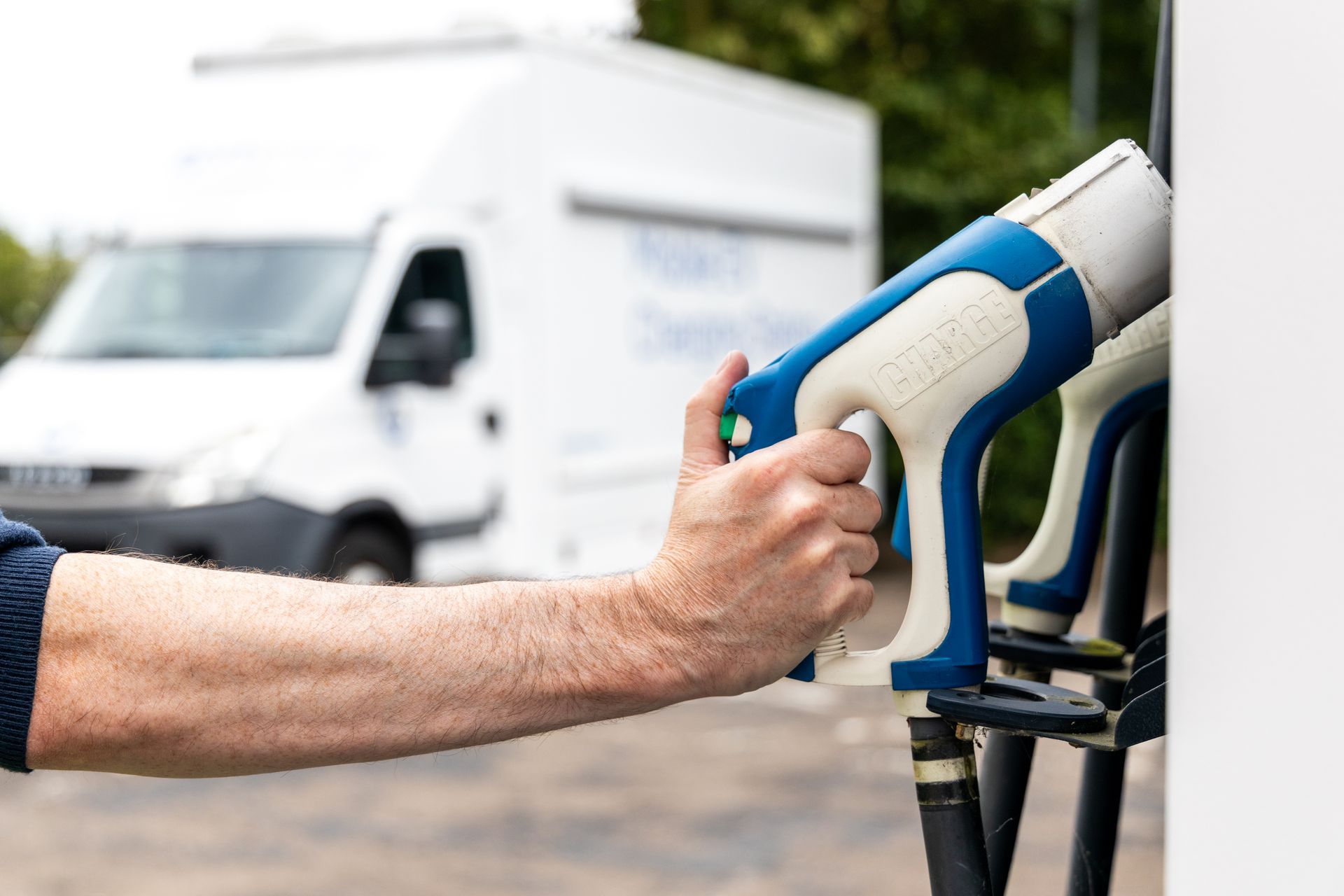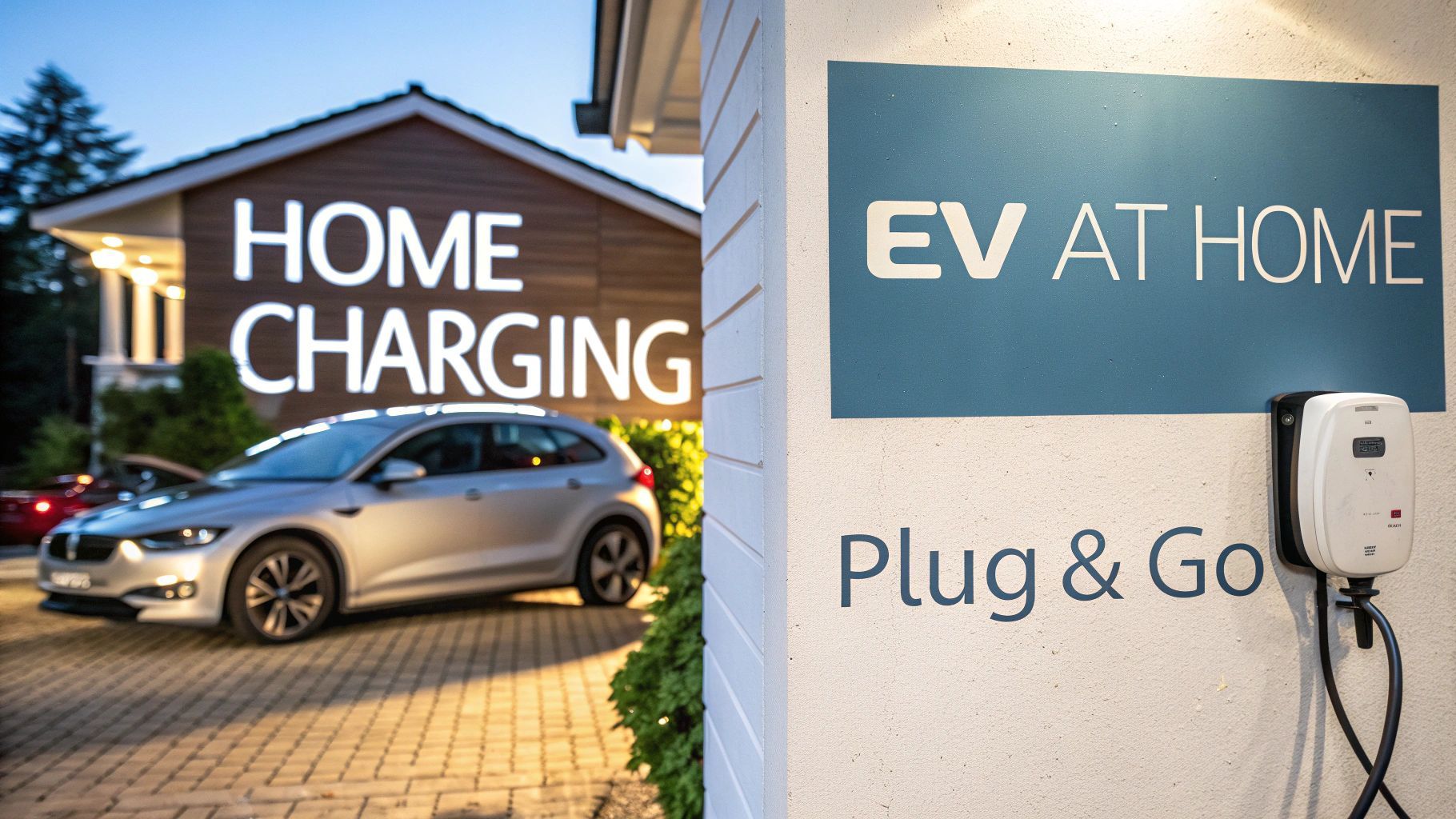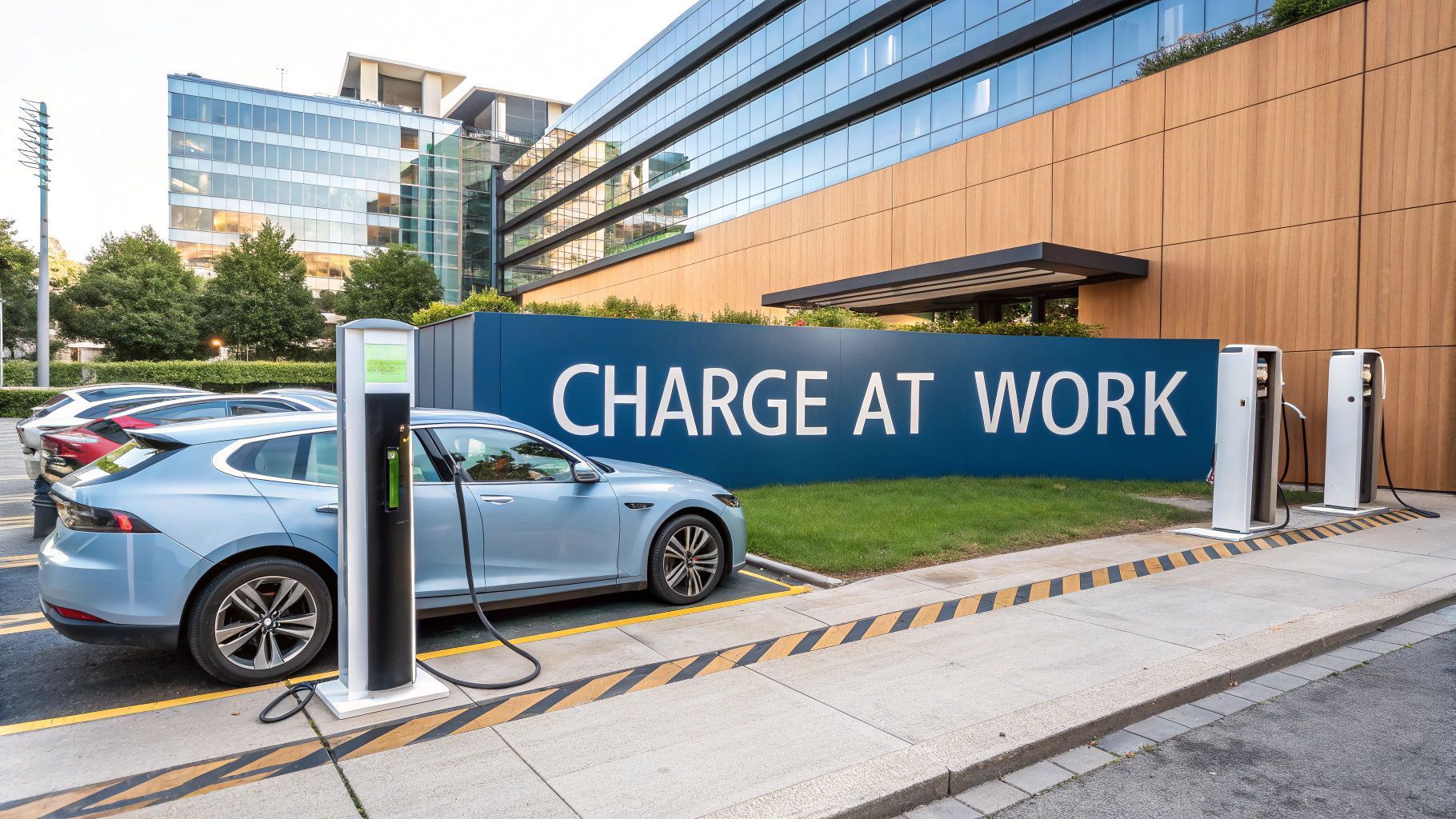EV Fleet Charging Solutions Guide
Switching your commercial fleet to electric vehicles throws up a big question: how do you keep everything running smoothly while actually improving your bottom line? The answer is not just buying the vehicles; it is nailing your charging strategy. This guide breaks down the two main EV fleet charging solutions —the traditional fixed depot model and the more flexible mobile approach—to help you figure out what is right for your business.
Navigating Your Fleet Electrification Journey
Moving to an electric fleet is about so much more than just the vehicles themselves. It forces a complete rethink of your energy infrastructure. The success of your entire project hangs on choosing a charging solution that fits your operations like a glove, making sure your vehicles are always charged and ready to roll without creating costly downtime. It helps to start with a broad understanding of general electric car charging solutions that apply to everyone.
For commercial fleets though the stakes are so much higher. Get the strategy wrong and you could face operational gridlock. But get it right and you have just created a major competitive advantage.
Moving Beyond Technical Details
We are going to move past simply listing technical specs. Instead we will explore the real-world business cases for the two main ways to charge a fleet: fixed and mobile.
We will look at traditional depot charging, known for its reliable overnight power and compare it with the get-up-and-go versatility of mobile, on-demand solutions. The goal is to give fleet managers a clear framework to decide which approach best supports their daily workflow, vehicle types and long-term financial targets.
A key idea to keep in mind is turning a necessary expense into a new source of income. While fixed charging is almost always a cost centre we will show how mobile charging can become a profitable service in its own right.
Ultimately picking the right EV fleet charging solution is about safeguarding your business's future. It is about ensuring you can hit your sustainability goals, boost efficiency and even uncover new ways to generate revenue. That journey starts with a clear, strategic understanding of your options.
Analysing Your Fleet's Unique Charging Profile
Before you even think about hardware the very first step is to get under the skin of your fleet's daily life. It is about building a detailed ‘charging persona’ for your business.
Think of it like a personal trainer creating a nutrition plan for an athlete; a sprinter’s energy needs are worlds apart from a marathon runner’s. In the same way your EV charging setup has to be perfectly matched to your fleet’s unique operational rhythm.
This means mapping out your entire operation from start to finish. You need to look at daily mileage, the types of vehicles you run, typical dwell times (how long they are stationary) and routing patterns. Nailing these details is the only way to avoid costly mistakes and choose a solution that genuinely supports your workflow, keeping your vehicles on the road where they belong.
Defining Your Fleet's Demands
To build an accurate profile you will need to gather data on a few key operational metrics. Once you do a clear picture of your energy requirements will emerge, making your infrastructure decisions much more straightforward.
- Vehicle Dwell Time: Where do your vehicles actually park and for how long? Are they at a depot overnight? Parked up for short bursts between jobs? Or are they spending time at public spots during the day?
- Daily Mileage and Routes: Do your vehicles follow the same predictable routes and mileage each day or is their work more varied and unpredictable?
- Vehicle Types: A fleet of light commercial vans has completely different battery sizes and charging needs compared to heavy goods vehicles or a fleet of passenger cars.
Getting a handle on the overall health of your vehicles, including battery performance and efficiency, is also vital for getting your charging cycles right. Advanced tools that deliver crucial data can make a huge difference here, giving you accurate analysis and vehicle health monitoring. This level of insight helps you plan your energy consumption far more effectively.
Navigating the Public Charging Network
Once you have got a clear picture of your own needs you have to look at the world outside your depot. The UK government’s £1.6 billion investment has massively expanded the public charging network, which is a big deal for fleets that operate far from a central hub.
By July 2025 the number of public chargers shot up to 84,218 —a 30% jump in just one year. But this growth comes with its own headaches for fleet managers. Only 20% of these chargers are the rapid kind needed for a quick turnaround while nearly half are slower "destination" chargers. This uneven landscape means balancing your reliance on public infrastructure with your own private hubs is now a key strategic decision. You can dig deeper into these EV charging statistics on meteorelectrical.com.
By carefully defining your fleet’s specific demands you transform the complex task of choosing an EV fleet charging solution into a straightforward business decision. This profile becomes your blueprint for building an efficient, cost-effective and resilient electric fleet.
Depot Charging vs Mobile Charging
Once you have got a clear picture of what your fleet needs day-to-day the next step is picking the right tool for the job. Your decision really boils down to two different ways to approach EV fleet charging: the traditional, fixed depot model and the flexible, on-demand mobile alternative. Each has its place but they solve very different problems.
Depot charging is the established workhorse. It is all about installing permanent charging points at your home base, which is perfect for fleets that return to the same spot every night. This approach offers reliability and predictability, letting vehicles top up slowly overnight when electricity tariffs are often cheaper.
But that reliability can come with some serious headaches. The upfront costs for hardware and installation can be steep but the biggest hurdle is often the local power grid. Many commercial depots just do not have the electrical muscle to support a large bank of chargers. This can lead to expensive and painfully slow grid upgrade negotiations with utility providers—a process that can drag on for months or even years.
The Rise of Mobile Charging Flexibility
This is where mobile charging comes in as a powerful and versatile alternative. Instead of bringing your vehicles to the power a mobile solution brings the power directly to your vehicles. Think of it as a power bank on wheels for your entire fleet.
This approach immediately gets around the grid constraint problem. A mobile unit can be rolled out to any site, no matter its existing electrical setup, delivering a fast charge exactly where it is needed. This makes it a perfect fit for fleets that operate from multiple sites, use rented locations or are based in areas with grid limitations. You can dig deeper into the differences and explore the future of EV charging with stationary vs mobile solutions to get the full picture.
This decision tree helps visualise which solution might be the right fit for you based on daily mileage and how long your vehicles are typically parked.

As you can see fleets with predictable routes and long overnight stops are ideal candidates for depot charging. On the other hand those with varied routes and shorter dwell times will get far more out of mobile flexibility.
Comparing Depot and Mobile EV Fleet Charging Solutions
To make the choice a bit clearer let's put the two EV fleet charging solutions side-by-side and look at the factors that really matter to fleet managers.
| Attribute | Fixed Depot Charging | Mobile On-Demand Charging |
|---|---|---|
| Upfront Cost | High (hardware, installation, grid upgrades) | Moderate (vehicle and charger purchase) |
| Deployment Speed | Slow (months to years for grid connection) | Fast (can be operational within weeks) |
| Flexibility | Low (fixed to a single location) | High (can serve multiple sites and vehicles) |
| Scalability | Difficult and expensive to expand | Easy to scale by adding more units |
| Grid Dependence | Entirely dependent on local grid capacity | Independent of local grid infrastructure |
Ultimately mobile charging gives you a crucial layer of operational resilience. It can act as an emergency backup if your depot chargers fail, provide power during an outage or support temporary busy periods without you needing to invest in permanent infrastructure. It is about having power where you need it, when you need it.
Unlocking Profit with Mobile Charging as a Service

While depot charging is usually seen as a necessary cost a mobile unit is a different beast altogether. Think of it less as an operational expense and more as a dynamic asset that can actively bring in revenue. This simple shift in perspective turns your EV charging setup into a strategic business opportunity.
A mobile charger is not just for your own fleet; it is a new profit centre waiting to be switched on. By looking beyond your own needs you can build entirely new services that not only pay for the charger itself but also contribute directly to your bottom line. The key is to see it as a flexible power source you can deploy for commercial gain.
Building New Revenue Streams
The sheer versatility of a mobile unit opens up several practical business models. Each one is designed to fill a specific gap in the market, transforming your charger into a valuable service for other businesses and EV drivers in your area.
- Charging as a Service (CaaS) for Businesses: Offer scheduled top-up charging to local businesses that do not have their own infrastructure. This is a perfect fit for companies with small EV fleets, delivery services or those renting premises where installing fixed chargers just is not an option.
- Emergency Roadside Assistance: Become a lifeline for EV drivers who run out of charge. A rapid mobile response can get a stranded driver moving again in minutes—a premium service that people are happy to pay for.
- Event and Temporary Site Power: Supply on-demand charging for festivals, construction sites or film sets where fixed power is unavailable. This B2B service can lock in lucrative multi-day contracts.
These models work because they plug the holes in the UK's current charging network. While the infrastructure is growing it is far from consistent. As of 2025 there are just 113 public chargers per 100,000 people nationally. That number hides huge regional disparities, with London enjoying 263 per 100,000 while Northern Ireland has only 35 . Mobile charging can service these deserts and you can explore more of these EV charging statistics on uswitch.com.
Calculating Your Potential Earnings
So what does this look like in pounds and pence? Let's run some numbers. The model is straightforward: you charge a margin on the electricity you deliver and add a service fee for the convenience.
Let’s say it costs you £0.30 per kilowatt-hour (kWh) to charge your mobile unit overnight at your depot on an off-peak tariff. You can then sell that energy at a premium—perhaps £0.70 per kWh—and add a call-out or service fee on top.
Turning your mobile charger into a profit-making asset is all about spotting local demand and setting up a simple, transparent pricing structure. You are monetising the convenience and flexibility that only a mobile unit can offer.
Here is a breakdown of what a potential week of commercial activity could look like:
| Service Type | Sessions per Week | Avg. kWh Delivered | Revenue per kWh (@ £0.70) | Service Fee | Weekly Total |
|---|---|---|---|---|---|
| Business CaaS | 10 | 40 kWh | £280.00 | £150.00 (£15/session) | £430.00 |
| Roadside Assist | 3 | 25 kWh | £52.50 | £180.00 (£60/call) | £232.50 |
| Event Power | 1 | 200 kWh | £140.00 | £250.00 (day rate) | £390.00 |
| Total Revenue | £1,052.50 |
This quick projection shows a potential weekly revenue of over £1,000 . After subtracting the cost of the electricity used (375 kWh @ £0.30 = £112.50), the gross profit is substantial. It shows how a strategically deployed mobile unit can pay for itself quickly and become a valuable income stream. For a deeper analysis you can learn more about the economics of mobile EV charging in our detailed guide.
Implementing Your Fleet Charging Strategy
You have weighed the options and picked your path—fixed depot chargers or a nimble mobile solution. Now comes the real work: turning that strategy into a reality. This is where theory meets the tarmac and paying close attention to the details will make all the difference in getting your EV fleet charging up and running smoothly.
For anyone installing permanent depot chargers the journey starts with a good, hard look at your site. It is about more than just finding a spot for the hardware. You will need to dig into your site’s grid capacity and get to grips with the often-tricky process of securing planning permissions. For a detailed walkthrough you can check out our guide on UK commercial EV charging installation .
On the other hand if you have opted for a mobile charging strategy your focus shifts from concrete and cables to pure operational logistics. The main jobs are outfitting the host vehicle correctly and crucially establishing rock-solid safety protocols for the operators who will be delivering power out in the field.
Essential Steps for Fixed Depot Installations
Deploying a fixed charging hub is not something you can rush. Careful planning is the only way to sidestep the common and often expensive pitfalls that can trip up even the most seasoned fleet managers. A structured approach is absolutely essential.
- Grid Capacity Assessment: First things first, can your existing electrical supply handle the extra load? This nearly always means working with your local Distribution Network Operator (DNO) to figure out potential upgrade costs and how long it might take.
- Site Layout and Design: Where you put the chargers has a massive impact on your daily workflow. Think about how vehicles will move around, how easy it is for drivers to access the charge points and how you will manage all the cabling to keep things efficient and safe.
- Navigating Permissions: Depending on how big your installation is you will almost certainly need to deal with local planning permissions and building regulations. Getting in touch with the local authorities early on can save you from major delays down the line.
Operationalising Your Mobile Charging Solution
Getting a mobile charging service off the ground involves a different playbook, one that is centred on efficiency and safety above all else.
A mobile charging unit is a dynamic asset that operates in public spaces so your implementation must prioritise clear operational procedures and robust safety measures above all else. This builds trust with both your operators and your customers.
The UK's public charging network is growing fast, with 82,002 devices expected to be available by July 2025—that is a 27% jump in just one year. But this growth is not spread evenly. London, for example, has 263 chargers for every 100,000 people while the national average is just 113 . You can explore the full breakdown in these UK public charging infrastructure statistics .
This patchiness creates clear openings for mobile charging operators to step in and service those underserved areas. Success however hangs on having smart software to manage everything from scheduling and payments to vehicle monitoring, helping you send your mobile units exactly where demand is highest.
Looking Ahead: Future-Proofing Your Fleet for the Electric Era
Choosing the right EV charging solution is not just a purchase; it is a major investment in your business's ability to adapt and thrive. The best path forward is always one designed around your unique operational needs, carefully balancing the trade-offs between fixed depot charging and more flexible mobile solutions.
A smart strategy ensures your vehicles stay powered up and productive, smoothing your transition to electric without tripping up your efficiency.
And it does not stop there. Emerging technologies like vehicle-to-grid (V2G) are on the horizon, promising even bigger opportunities. Imagine your fleet's batteries acting as a decentralised energy store, selling power back to the grid during peak demand. This flips the script entirely, turning your vehicles from simple assets into active players in the energy market, opening up entirely new ways to generate revenue.
By making an informed, strategic choice today you are not just hitting sustainability targets—you are unlocking new operational efficiencies. That kind of foresight will secure a powerful competitive advantage in the years to come, marking you out as a leader.
The journey to an all-electric fleet is an ongoing one but the right charging infrastructure is what makes it profitable. Whether you land on a fixed, mobile or hybrid model, that choice will be the foundation for a robust and future-proof electric fleet. It is this forward-thinking approach that will define the leaders in tomorrow’s logistics and transport sectors.
Still Have Questions About Fleet Charging?
Finalising your EV fleet charging strategy can feel like the last piece of a complex puzzle. It is normal to have a few questions left over. Here are some clear answers to the most common queries we hear from fleet managers, designed to help you move forward with confidence.
What Is the Biggest Hidden Cost of Depot Charging?
Beyond the chargers themselves the single biggest surprise cost is often the grid connection upgrade .
If your depot’s existing power supply cannot handle the new electrical load the expense to upgrade it can be huge. Worse still the process of negotiating and completing this work with utility providers can lead to project delays that stretch on for months.
How Much Revenue Can a Mobile Charger Generate?
This really comes down to your business model, service area and how often the unit is in use. A smartly deployed mobile charger offering commercial top-ups and emergency roadside assistance can easily generate thousands of pounds in revenue each month.
With a solid plan it is entirely realistic for a mobile charging unit to pay for itself within 18-24 months . It can quickly transform from an operational tool into a powerful profit centre for your business.
Is Mobile Charging Powerful Enough for Commercial Vehicles?
Absolutely. Today’s mobile EV charging solutions are more than capable of servicing commercial vehicles.
Many of our units can deliver DC fast charging at 50kW or even higher. This is more than enough power to give a commercial van or lorry a significant range boost in under an hour, which is vital for minimising vehicle downtime and keeping your fleet on the move.
Ready to transform your fleet's charging strategy from a cost centre into a revenue stream? Explore mobile EV fleet charging solutions with ZAPME and discover the power of flexible, on-demand energy. Find out more about what ZAPME can do for you.











